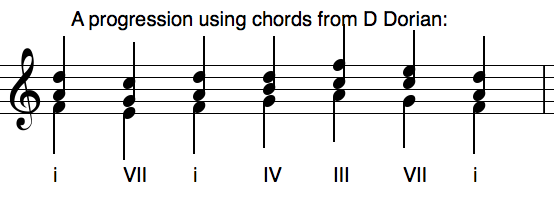Answer: Phew. That's a deep one, but I'll wade in from the shallow end. First there's the historical distinction between mode and key. There's a fine book by Joel Lester, Between Modes and Keys, that provides interesting detail about the transition from modal to harmonic thinking. Modal music was primarily concerned with the horizontal or melodic aspects of music; "chord progressions" did not come along until later.
But I suspect you're really asking about the term as applied in jazz or folk music. In that case the term "modal harmony" really should just refer to building chords using the notes found in one of the old modes, rather than sticking to major or minor scales. This is not actually "modal" in the original sense of the word because the modes preceded chordal harmony. But the term could be used to describe chord progressions in which triads are built in the usual manner on notes of a scale, using the scale tones, except that the scale is not major or the usual minor, but one of the modal patterns.
For instance, the Dorian mode (in modern terms, the white keys from D) has a major sixth but a minor third. So if you build a chord on its 4th degree and use just scale tones you'll have a major IV in what otherwise sounds like a minor key. More commonly you'll hear a minor tune with a natural seventh (a whole step down from the tonic), and if that is harmonized using just scale tones you'll again have an effect different from typical major/minor progressions: the major VII chord. This could be said to derive from the Aeolian mode (natural minor) or the Dorian, so it's "modal harmony," too. Another would be a chord built on the low seventh in major (again a whole step from the tonic). This would derive from the Mixolydian mode, which is basically major but with a whole step below the tonic.
The basic principle is very simple: chords are usually built using tones from the current scale, so you just lay them out as they come. If that scale is not major or harmonic minor, then you could say you've got modal harmony.
For example, here are the chords that would naturally arise from Dorian on D:
i D minor (D, F, A). As in normal minor.
ii E minor (E, G, B). Minor would have a diminished triad here.
III F major (F, A, C). As in normal minor.
IV G major (G, B, D). Minor would have a minor triad on the IV degree.
v A minor (A, C, E). Tonal harmony ("harmonic minor") would raise the C# here to make a major V chord, but a minor v is "modal."
vi dim (B, D, F) (but who wants to use that). If this were normal minor, the B would be flatted and this would be a major chord.
VII major (C, E, G). Which is as it would be in "natural minor (Aeolian)," but in tonal harmony using harmonic minor could be a diminished chord on C#.

I have read a description claiming that modal harmony has to do with leaving out the thirds in triads, or in using drone effects, or staying pretty much on one chord in various positions. I don't buy that. Let's say that modal harmony is that which uses chords that are built from only the tones available in one of the modes: Dorian, Phrygian, Lydian, Mixolydian, Aeolian. If someone wants to make a composition using drones or a constant single chord, I think a better term would be "static harmony." Not that there's anything wrong with that.

